The system of the English phonemes
The system of the English phonemes
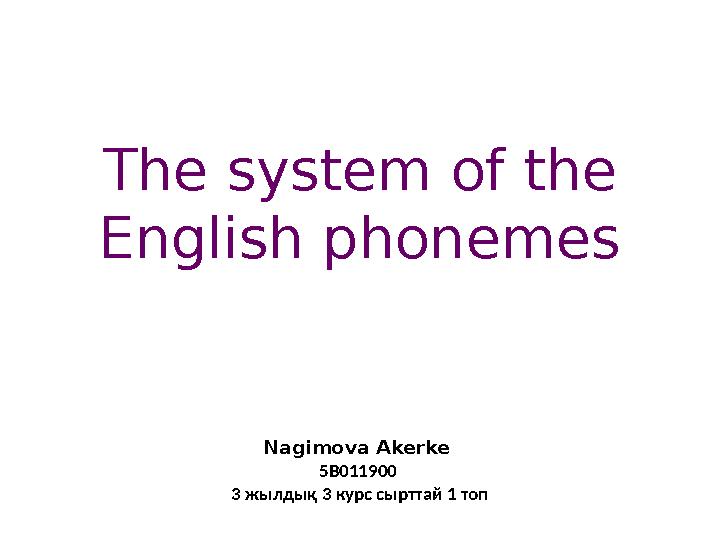

#1 слайд
The system of the
English phonemes
Nagimova Akerke
5B011900
3 жылдық 3 курс сырттай 1 топ
1 слайд
The system of the English phonemes Nagimova Akerke 5B011900 3 жылдық 3 курс сырттай 1 топ
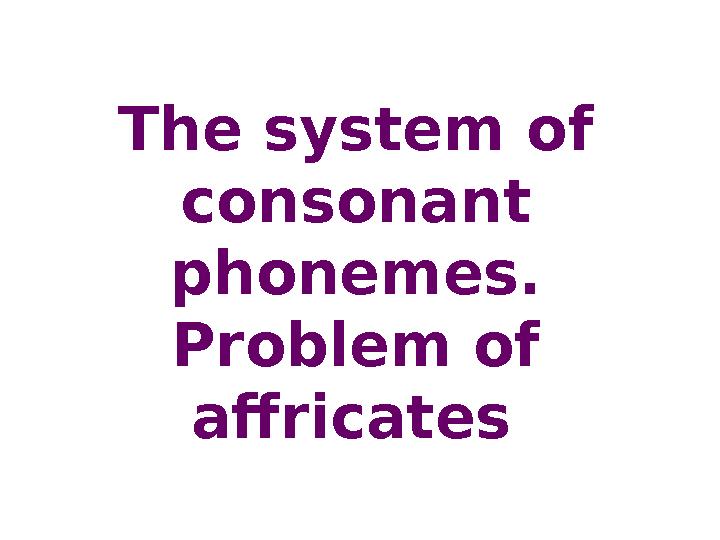
#2 слайд
The system of
consonant
phonemes.
Problem of
affricates
2 слайд
The system of consonant phonemes. Problem of affricates
![There are 24 phonemes: [p, b, t, d, k, g, f, v, θ, ð, s, z, ∫, g , h, t∫, d g , m, n, ŋ, w, r, 1, j]. There are 24 phonemes: [p, b, t, d, k, g, f, v, θ, ð, s, z, ∫, g , h, t∫, d g , m, n, ŋ, w, r, 1, j].](https://api.ust.kz/storage/files/materials/pptx/image/2019/march/d29/1553878968-3.jpeg)
#3 слайд
There are 24 phonemes: [p,
b, t, d, k, g, f, v, θ, ð, s, z,
∫, g , h, t∫, d g , m, n, ŋ, w,
r, 1, j].
3 слайд
There are 24 phonemes: [p, b, t, d, k, g, f, v, θ, ð, s, z, ∫, g , h, t∫, d g , m, n, ŋ, w, r, 1, j].
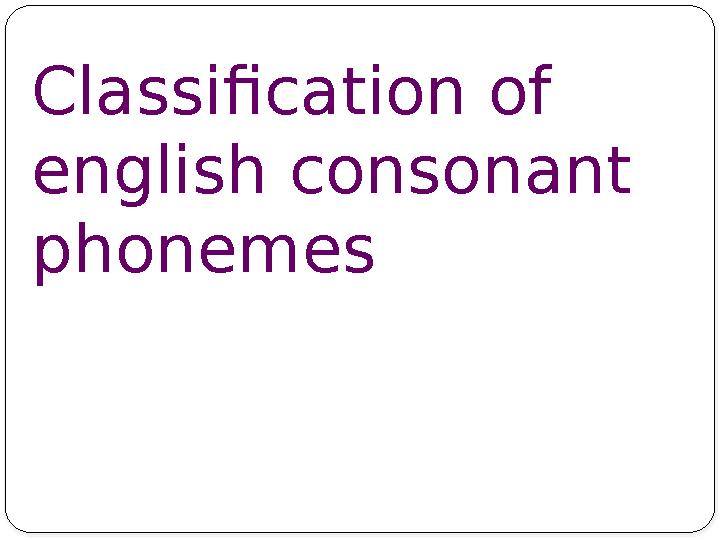
#4 слайд
Classification of
english consonant
phonemes
4 слайд
Classification of english consonant phonemes
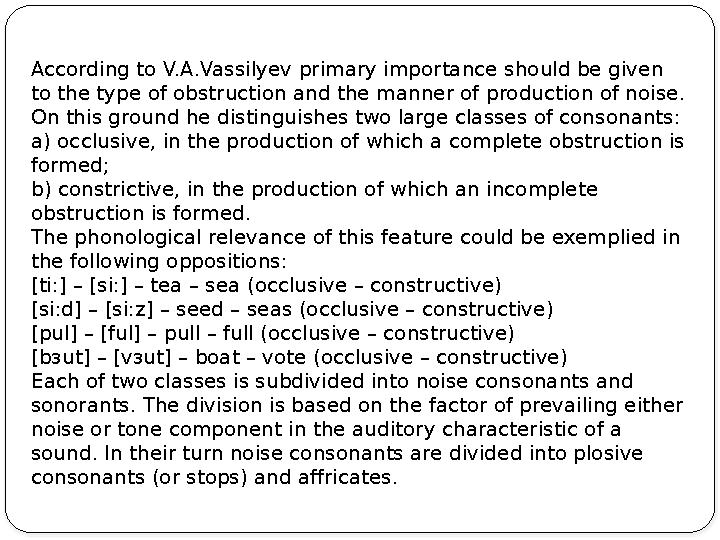
#5 слайд
According to V.A.Vassilyev primary importance should be given
to the type of obstruction and the manner of production of noise.
On this ground he distinguishes two large classes of consonants:
a) occlusive, in the production of which a complete obstruction is
formed;
b) constrictive, in the production of which an incomplete
obstruction is formed.
The phonological relevance of this feature could be exemplied in
the following oppositions:
[ti:] – [si:] – tea – sea (occlusive – constructive)
[si:d] – [si:z] – seed – seas (occlusive – constructive)
[pul] – [ful] – pull – full (occlusive – constructive)
[bзut] – [vзut] – boat – vote (occlusive – constructive)
Each of two classes is subdivided into noise consonants and
sonorants. The division is based on the factor of prevailing either
noise or tone component in the auditory characteristic of a
sound. In their turn noise consonants are divided into plosive
consonants (or stops) and affricates.
5 слайд
According to V.A.Vassilyev primary importance should be given to the type of obstruction and the manner of production of noise. On this ground he distinguishes two large classes of consonants: a) occlusive, in the production of which a complete obstruction is formed; b) constrictive, in the production of which an incomplete obstruction is formed. The phonological relevance of this feature could be exemplied in the following oppositions: [ti:] – [si:] – tea – sea (occlusive – constructive) [si:d] – [si:z] – seed – seas (occlusive – constructive) [pul] – [ful] – pull – full (occlusive – constructive) [bзut] – [vзut] – boat – vote (occlusive – constructive) Each of two classes is subdivided into noise consonants and sonorants. The division is based on the factor of prevailing either noise or tone component in the auditory characteristic of a sound. In their turn noise consonants are divided into plosive consonants (or stops) and affricates.

#6 слайд
Another point of is that the first and basic
principle of classification should be the degree
noise. Such consideration leads to dividing
English consonants into two general kinds:
A — noise consonants
B — sonorants
in production of sonorants the air passage
between the two organs of speech is fairly
wide, that is much wider than in the
production of noise consonants. As a result,
the auditory effect is tone, not noise - [r], [j],
[w], for example. They are also characterized
by sharply defined formant structure and the
total energy of most of them is very high.
6 слайд
Another point of is that the first and basic principle of classification should be the degree noise. Such consideration leads to dividing English consonants into two general kinds: A — noise consonants B — sonorants in production of sonorants the air passage between the two organs of speech is fairly wide, that is much wider than in the production of noise consonants. As a result, the auditory effect is tone, not noise - [r], [j], [w], for example. They are also characterized by sharply defined formant structure and the total energy of most of them is very high.
![The phonological relevance of the degree of noise could be proved by the following oppositions: [beik] — [meik] bake — make The phonological relevance of the degree of noise could be proved by the following oppositions: [beik] — [meik] bake — make](https://api.ust.kz/storage/files/materials/pptx/image/2019/march/d29/1553878968-7.jpeg)
#7 слайд
The phonological relevance of
the degree of noise could be
proved by the following
oppositions:
[beik] — [meik] bake — make
(noise consonant — sonorant)
[vi:l – [wi:l] veal — wheel (noise
consonant — sonorant)
7 слайд
The phonological relevance of the degree of noise could be proved by the following oppositions: [beik] — [meik] bake — make (noise consonant — sonorant) [vi:l – [wi:l] veal — wheel (noise consonant — sonorant)
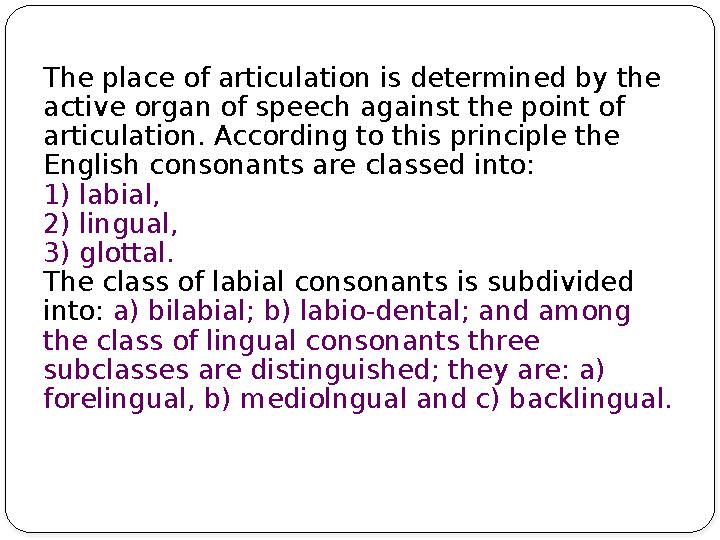
#8 слайд
The place of articulation is determined by the
active organ of speech against the point of
articulation. According to this principle the
English consonants are classed into:
1) labial,
2) lingual,
3) glottal.
The class of labial consonants is subdivided
into: a) bilabial; b) labio-dental; and among
the class of lingual consonants three
subclasses are distinguished; they are: a)
forelingual, b) mediolngual and c) backlingual.
8 слайд
The place of articulation is determined by the active organ of speech against the point of articulation. According to this principle the English consonants are classed into: 1) labial, 2) lingual, 3) glottal. The class of labial consonants is subdivided into: a) bilabial; b) labio-dental; and among the class of lingual consonants three subclasses are distinguished; they are: a) forelingual, b) mediolngual and c) backlingual.
![pan — tan (bilabial - forelingual) [wai] - [lai] why — lie (bilabial — forelingual) [weil] - [jeil] weil — yale (bilabial - me pan — tan (bilabial - forelingual) [wai] - [lai] why — lie (bilabial — forelingual) [weil] - [jeil] weil — yale (bilabial - me](https://api.ust.kz/storage/files/materials/pptx/image/2019/march/d29/1553878968-9.jpeg)
#9 слайд
pan — tan (bilabial - forelingual)
[wai] - [lai] why — lie (bilabial — forelingual)
[weil] - [jeil] weil — yale (bilabial - mediolingual)
[pik] - [kik] pick — kick (bilabial - backlingual)
[les] — [jes] less — yes (forelingual .—
mediolingual)
[dei] — [gei] day — gay (forelingual —
backlingual)
[sai] - [hai] sigh — high (forelingual — glottal)
[fi:t] - [si:t] feet — seat (labio-dental —
forelingual)
9 слайд
pan — tan (bilabial - forelingual) [wai] - [lai] why — lie (bilabial — forelingual) [weil] - [jeil] weil — yale (bilabial - mediolingual) [pik] - [kik] pick — kick (bilabial - backlingual) [les] — [jes] less — yes (forelingual .— mediolingual) [dei] — [gei] day — gay (forelingual — backlingual) [sai] - [hai] sigh — high (forelingual — glottal) [fi:t] - [si:t] feet — seat (labio-dental — forelingual)
![Another sound property is voiced — voiceless characteristic which depends on the work of the vocal cords. [p, b], [t, d], [ Another sound property is voiced — voiceless characteristic which depends on the work of the vocal cords. [p, b], [t, d], [](https://api.ust.kz/storage/files/materials/pptx/image/2019/march/d29/1553878968-10.jpeg)
#10 слайд
Another sound property is
voiced — voiceless
characteristic which depends on
the work of the vocal cords. [p,
b], [t, d], [k, g], [s, z]. All voiced
consonants are weak (lenis) and
all voiceless consonants are
strong (fortis).
10 слайд
Another sound property is voiced — voiceless characteristic which depends on the work of the vocal cords. [p, b], [t, d], [k, g], [s, z]. All voiced consonants are weak (lenis) and all voiceless consonants are strong (fortis).
![Thus it may be said that the oppositions [p — b], [t — d], [k — g], [f — v], [s — z], [f — 3], [tf — dj] are primarily based o Thus it may be said that the oppositions [p — b], [t — d], [k — g], [f — v], [s — z], [f — 3], [tf — dj] are primarily based o](https://api.ust.kz/storage/files/materials/pptx/image/2019/march/d29/1553878968-11.jpeg)
#11 слайд
Thus it may be said that the oppositions [p — b], [t — d], [k
— g], [f — v], [s — z], [f — 3], [tf — dj] are primarily based
on energy difference, that is on fortis — lenis articulation,
which are their phonologically relevant features. It is for
this reason that such characteristics as voiceless — voiced
have given place to "fortis" — "lenis" terms.
There is one more articulatory characteristic which is
usually included into the set of principles on the basis of
which the English consonants are classified, that is the
position of the soft palate. According to this principle
consonants can be oral and nasal. There are relatively few
consonantal types in English which require the lowered
position of the soft palate. They are the nasal occlusive
sonorants [m], [n] and. They differ from oral plosives in
that the soft palate is lowered allowing the escape of air
into the nasal cavity.
11 слайд
Thus it may be said that the oppositions [p — b], [t — d], [k — g], [f — v], [s — z], [f — 3], [tf — dj] are primarily based on energy difference, that is on fortis — lenis articulation, which are their phonologically relevant features. It is for this reason that such characteristics as voiceless — voiced have given place to "fortis" — "lenis" terms. There is one more articulatory characteristic which is usually included into the set of principles on the basis of which the English consonants are classified, that is the position of the soft palate. According to this principle consonants can be oral and nasal. There are relatively few consonantal types in English which require the lowered position of the soft palate. They are the nasal occlusive sonorants [m], [n] and. They differ from oral plosives in that the soft palate is lowered allowing the escape of air into the nasal cavity.
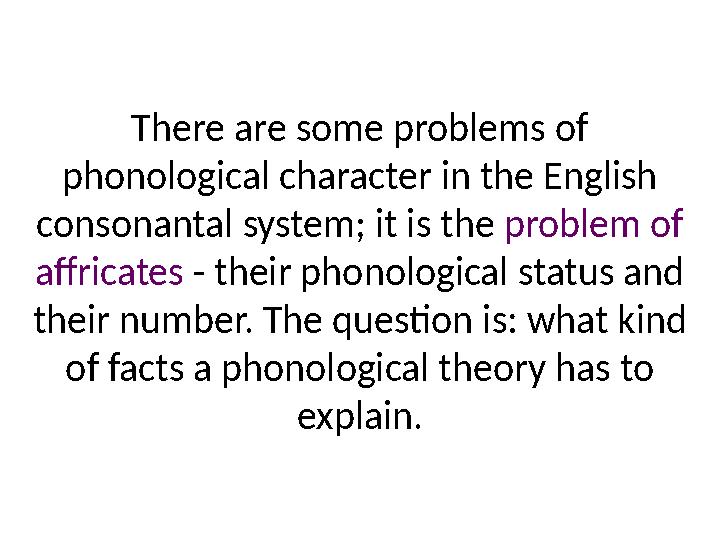
#12 слайд
There are some problems of
phonological character in the English
consonantal system; it is the problem of
affricates - their phonological status and
their number. The question is: what kind
of facts a phonological theory has to
explain.
12 слайд
There are some problems of phonological character in the English consonantal system; it is the problem of affricates - their phonological status and their number. The question is: what kind of facts a phonological theory has to explain.
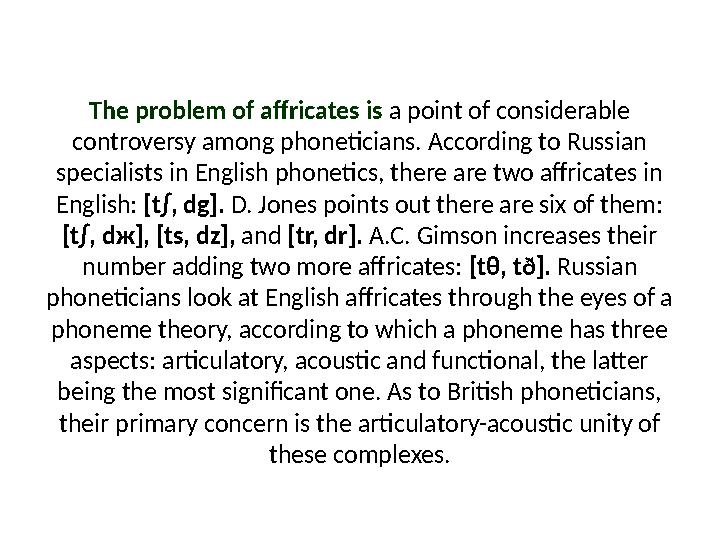
#13 слайд
The problem of affricates is a point of considerable
controversy among phoneticians. According to Russian
specialists in English phonetics, there are two affricates in
English: [t∫, d g ]. D. Jones points out there are six of them:
[t∫, dж], [ts, dz], and [tr, dr]. A.C. Gimson increases their
number adding two more affricates: [tθ, tð]. Russian
phoneticians look at English affricates through the eyes of a
phoneme theory, according to which a phoneme has three
aspects: articulatory, acoustic and functional, the latter
being the most significant one. As to British phoneticians,
their primary concern is the articulatory-acoustic unity of
these complexes.
13 слайд
The problem of affricates is a point of considerable controversy among phoneticians. According to Russian specialists in English phonetics, there are two affricates in English: [t∫, d g ]. D. Jones points out there are six of them: [t∫, dж], [ts, dz], and [tr, dr]. A.C. Gimson increases their number adding two more affricates: [tθ, tð]. Russian phoneticians look at English affricates through the eyes of a phoneme theory, according to which a phoneme has three aspects: articulatory, acoustic and functional, the latter being the most significant one. As to British phoneticians, their primary concern is the articulatory-acoustic unity of these complexes.
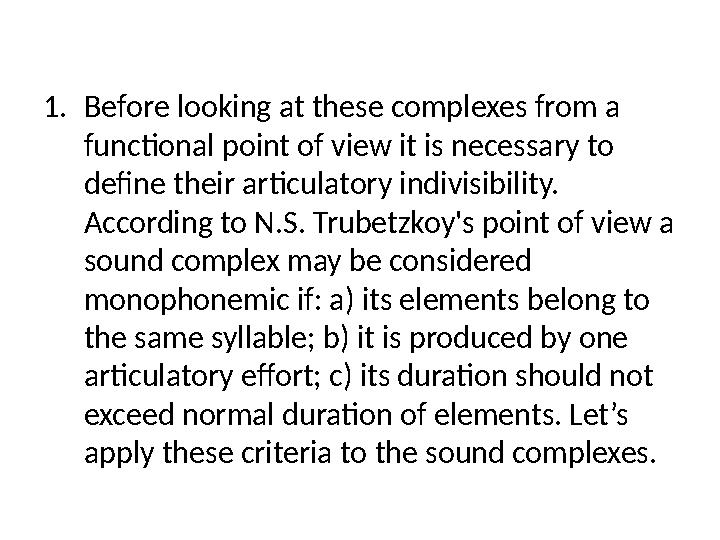
#14 слайд
1. Before looking at these complexes from a
functional point of view it is necessary to
define their articulatory indivisibility.
According to N.S. Trubetzkoy's point of view a
sound complex may be considered
monophonemic if: a) its elements belong to
the same syllable; b) it is produced by one
articulatory effort; c) its duration should not
exceed normal duration of elements. Let’s
apply these criteria to the sound complexes.
14 слайд
1. Before looking at these complexes from a functional point of view it is necessary to define their articulatory indivisibility. According to N.S. Trubetzkoy's point of view a sound complex may be considered monophonemic if: a) its elements belong to the same syllable; b) it is produced by one articulatory effort; c) its duration should not exceed normal duration of elements. Let’s apply these criteria to the sound complexes.
![1. Syllabic indivisibility butcher [but∫ -ə] lightship [lait-∫ip] mattress [mætr- is] footrest [fut- rest] 1. Syllabic indivisibility butcher [but∫ -ə] lightship [lait-∫ip] mattress [mætr- is] footrest [fut- rest]](https://api.ust.kz/storage/files/materials/pptx/image/2019/march/d29/1553878968-15.jpeg)
#15 слайд
1. Syllabic indivisibility
butcher [but∫ -ə] lightship [lait-∫ip]
mattress [mætr-
is] footrest [fut-
rest]
curtsey [kз:-tsi] out-set [aut-set]
eighth [eitθ] whitethorn [wait-
θo:n]
15 слайд
1. Syllabic indivisibility butcher [but∫ -ə] lightship [lait-∫ip] mattress [mætr- is] footrest [fut- rest] curtsey [kз:-tsi] out-set [aut-set] eighth [eitθ] whitethorn [wait- θo:n]
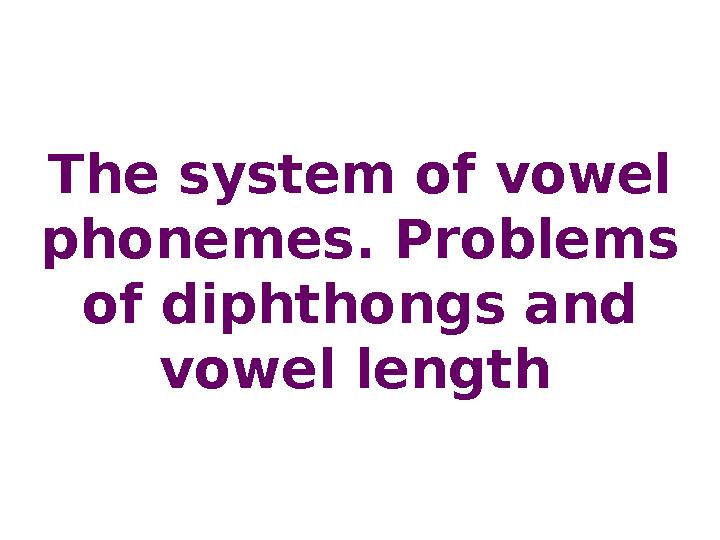
#16 слайд
The system of vowel
phonemes. Problems
of diphthongs and
vowel length
16 слайд
The system of vowel phonemes. Problems of diphthongs and vowel length

#17 слайд
The following 20 vowel
phonemes are distinguished
in BBC English (RP): [i:, a:,
o:, u:, з:, i, e, æ, σ, υ, л ,
ə; ei, ai, oi, аυ, eυ, υə, iə].
17 слайд
The following 20 vowel phonemes are distinguished in BBC English (RP): [i:, a:, o:, u:, з:, i, e, æ, σ, υ, л , ə; ei, ai, oi, аυ, eυ, υə, iə].
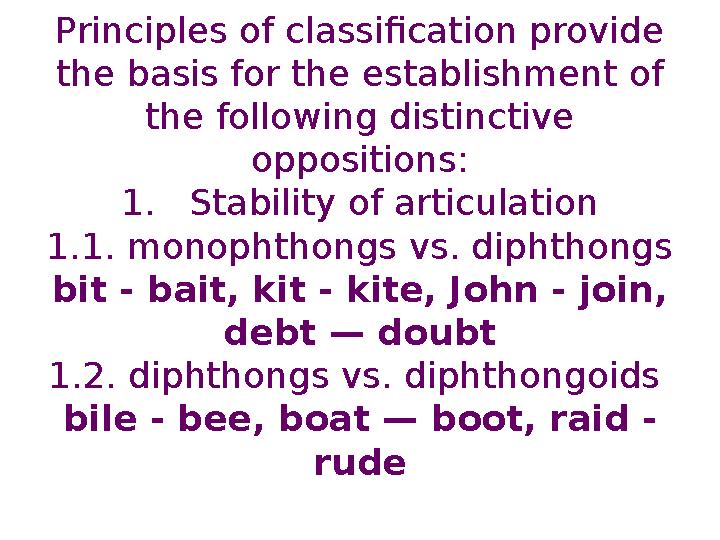
#18 слайд
Principles of classification provide
the basis for the establishment of
the following distinctive
oppositions:
1. Stability of articulation
1.1. monophthongs vs. diphthongs
bit - bait, kit - kite, John - join,
debt — doubt
1.2. diphthongs vs. diphthongoids
bile - bee, boat — boot, raid -
rude
18 слайд
Principles of classification provide the basis for the establishment of the following distinctive oppositions: 1. Stability of articulation 1.1. monophthongs vs. diphthongs bit - bait, kit - kite, John - join, debt — doubt 1.2. diphthongs vs. diphthongoids bile - bee, boat — boot, raid - rude
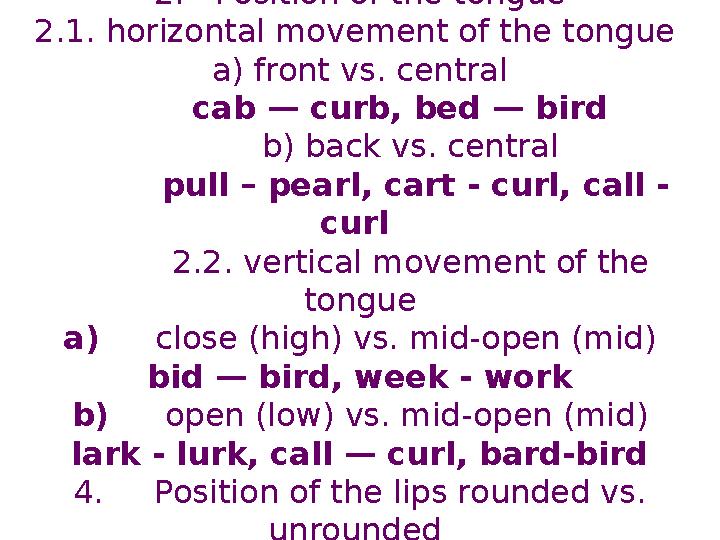
#19 слайд
2. Position of the tongue
2.1. horizontal movement of the tongue
a) front vs. central
cab — curb, bed — bird
b) back vs. central
pull – pearl, cart - curl, call -
curl
2.2. vertical movement of the
tongue
a) close (high) vs. mid-open (mid)
bid — bird, week - work
b) open (low) vs. mid-open (mid)
lark - lurk, call — curl, bard-bird
4. Position of the lips rounded vs.
unrounded
don — darn, pot - part
19 слайд
2. Position of the tongue 2.1. horizontal movement of the tongue a) front vs. central cab — curb, bed — bird b) back vs. central pull – pearl, cart - curl, call - curl 2.2. vertical movement of the tongue a) close (high) vs. mid-open (mid) bid — bird, week - work b) open (low) vs. mid-open (mid) lark - lurk, call — curl, bard-bird 4. Position of the lips rounded vs. unrounded don — darn, pot - part
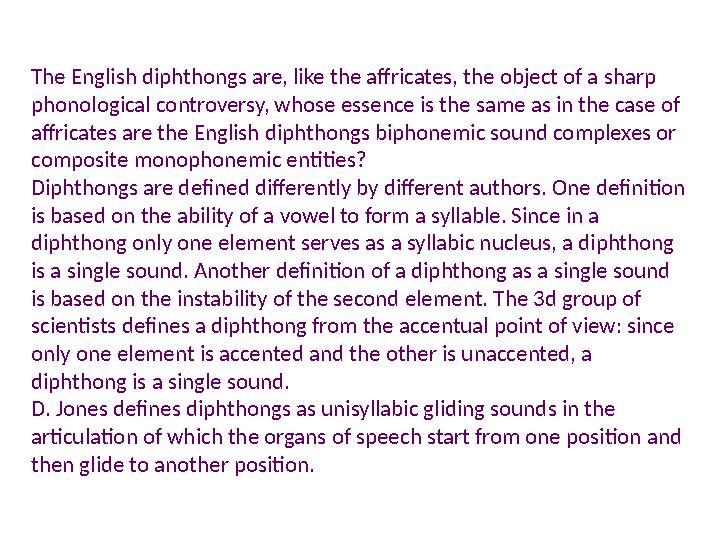
#20 слайд
The English diphthongs are, like the affricates, the object of a sharp
phonological controversy, whose essence is the same as in the case of
affricates are the English diphthongs biphonemic sound complexes or
composite monophonemic entities?
Diphthongs are defined differently by different authors. One definition
is based on the ability of a vowel to form a syllable. Since in a
diphthong only one element serves as a syllabic nucleus, a diphthong
is a single sound. Another definition of a diphthong as a single sound
is based on the instability of the second element. The 3d group of
scientists defines a diphthong from the accentual point of view: since
only one element is accented and the other is unaccented, a
diphthong is a single sound.
D. Jones defines diphthongs as unisyllabic gliding sounds in the
articulation of which the organs of speech start from one position and
then glide to another position.
20 слайд
The English diphthongs are, like the affricates, the object of a sharp phonological controversy, whose essence is the same as in the case of affricates are the English diphthongs biphonemic sound complexes or composite monophonemic entities? Diphthongs are defined differently by different authors. One definition is based on the ability of a vowel to form a syllable. Since in a diphthong only one element serves as a syllabic nucleus, a diphthong is a single sound. Another definition of a diphthong as a single sound is based on the instability of the second element. The 3d group of scientists defines a diphthong from the accentual point of view: since only one element is accented and the other is unaccented, a diphthong is a single sound. D. Jones defines diphthongs as unisyllabic gliding sounds in the articulation of which the organs of speech start from one position and then glide to another position.
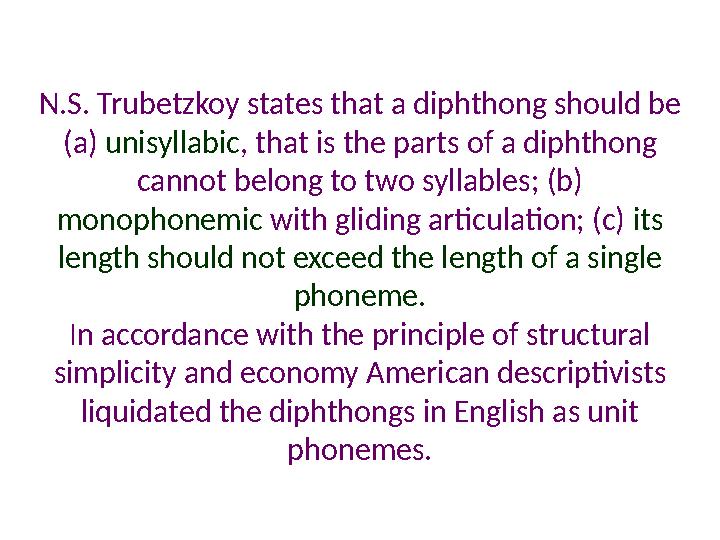
#21 слайд
N.S. Trubetzkoy states that a diphthong should be
(a) unisyllabic , that is the parts of a diphthong
cannot belong to two syllables; (b)
monophonemic with gliding articulation; (c) its
length should not exceed the length of a single
phoneme.
In accordance with the principle of structural
simplicity and economy American descriptivists
liquidated the diphthongs in English as unit
phonemes.
21 слайд
N.S. Trubetzkoy states that a diphthong should be (a) unisyllabic , that is the parts of a diphthong cannot belong to two syllables; (b) monophonemic with gliding articulation; (c) its length should not exceed the length of a single phoneme. In accordance with the principle of structural simplicity and economy American descriptivists liquidated the diphthongs in English as unit phonemes.
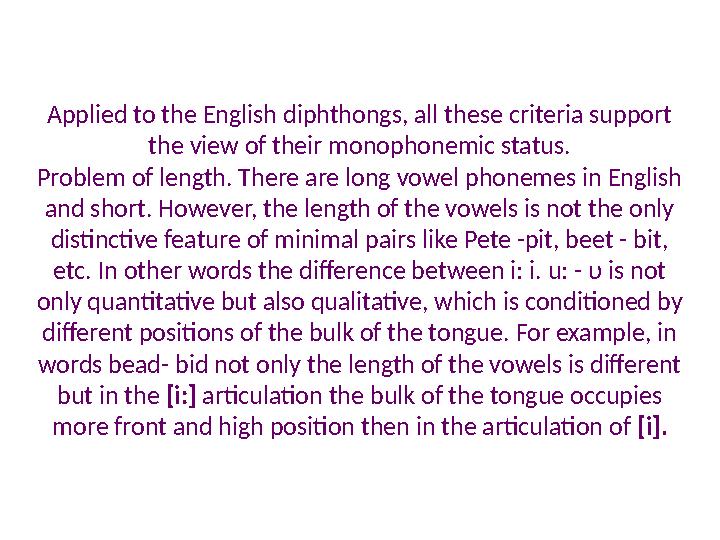
#22 слайд
Applied to the English diphthongs, all these criteria support
the view of their monophonemic status.
Problem of length. There are long vowel phonemes in English
and short. However, the length of the vowels is not the only
distinctive feature of minimal pairs like Pete -pit, beet - bit,
etc. In other words the difference between i: i. u: - υ is not
only quantitative but also qualitative, which is conditioned by
different positions of the bulk of the tongue. For example, in
words bead- bid not only the length of the vowels is different
but in the [i:] articulation the bulk of the tongue occupies
more front and high position then in the articulation of [i].
22 слайд
Applied to the English diphthongs, all these criteria support the view of their monophonemic status. Problem of length. There are long vowel phonemes in English and short. However, the length of the vowels is not the only distinctive feature of minimal pairs like Pete -pit, beet - bit, etc. In other words the difference between i: i. u: - υ is not only quantitative but also qualitative, which is conditioned by different positions of the bulk of the tongue. For example, in words bead- bid not only the length of the vowels is different but in the [i:] articulation the bulk of the tongue occupies more front and high position then in the articulation of [i].
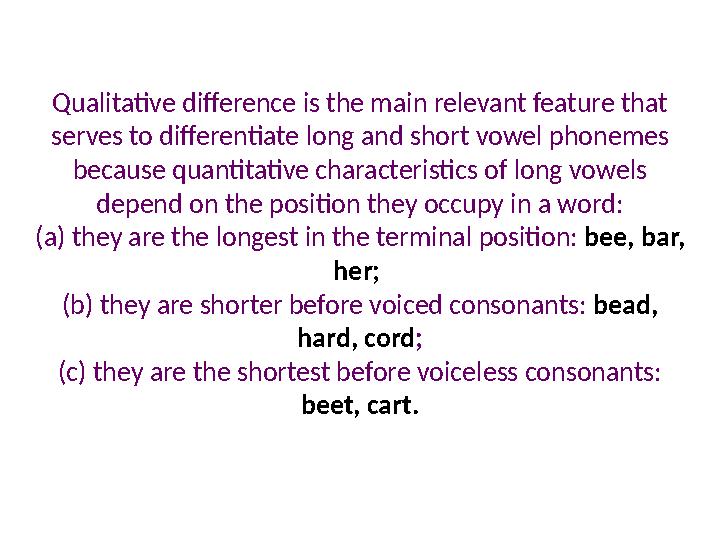
#23 слайд
Qualitative difference is the main relevant feature that
serves to differentiate long and short vowel phonemes
because quantitative characteristics of long vowels
depend on the position they occupy in a word:
(a) they are the longest in the terminal position: bee, bar,
her;
(b) they are shorter before voiced consonants: bead,
hard, cord ;
(c) they are the shortest before voiceless consonants:
beet, cart.
23 слайд
Qualitative difference is the main relevant feature that serves to differentiate long and short vowel phonemes because quantitative characteristics of long vowels depend on the position they occupy in a word: (a) they are the longest in the terminal position: bee, bar, her; (b) they are shorter before voiced consonants: bead, hard, cord ; (c) they are the shortest before voiceless consonants: beet, cart.

шағым қалдыра аласыз
















